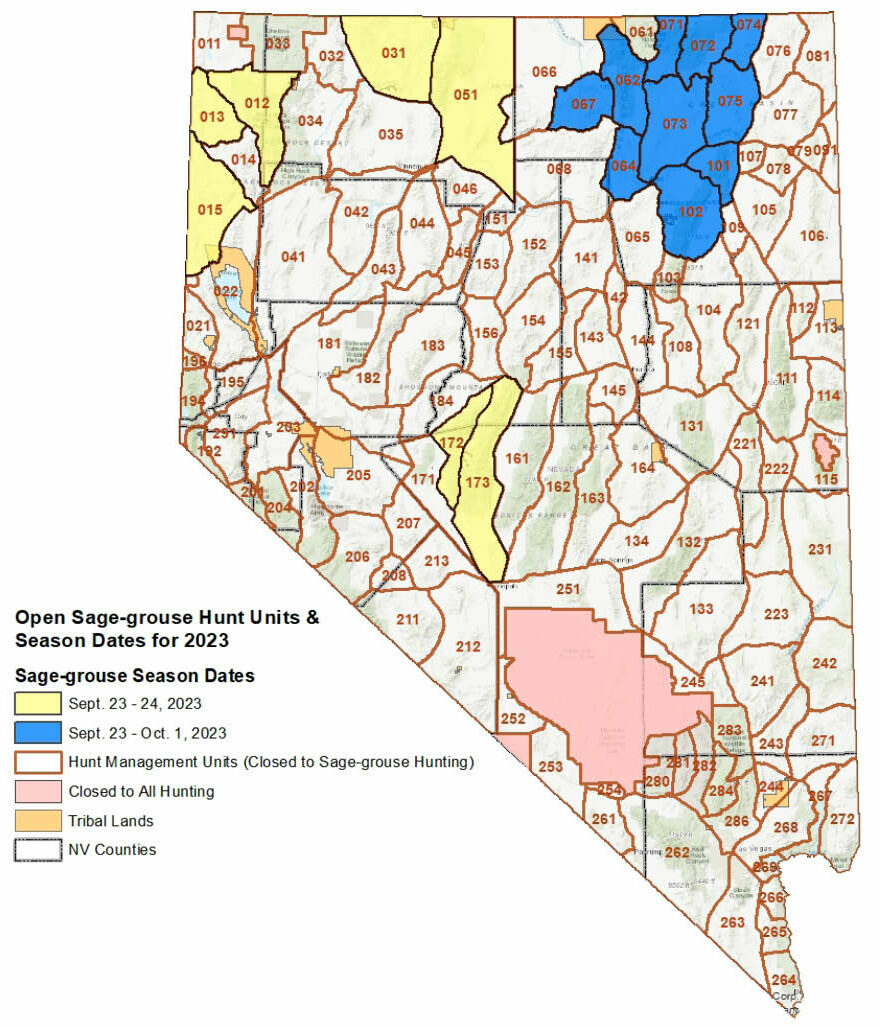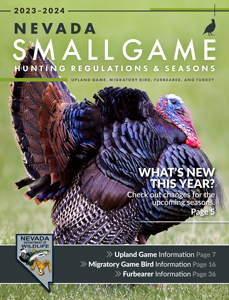Upland Game Bird, Rabbit, Dove & Crow
In Nevada, upland game bird species include dusky, sooty, and ruffed grouse; sage grouse; chukar and Hungarian partridge; Himalayan snowcock; ring-necked pheasant; California, Gambel’s, and mountain quail; and North American wild turkey.
Small game species include cottontail, and white-tailed jackrabbits. Falconry seasons are in effect for waterfowl (all migratory bird stamp requirements apply), dove, chukar, sage, blue and ruffed grouse, pheasant, Himalayan snowcock, Hungarian partridge, quail, and rabbit.
Youth seasons include chukar and Hungarian partridge, California and Gambel’s quail, and cottontail, and white-tailed jackrabbits.
NRS 502.010 as it pertains to Upland Game Youth Hunts
- A license to hunt or fish is not required of a resident of this State who is younger than 12;
- It is unlawful for any child who is younger than 18 to hunt any wildlife with any firearm unless the child is accompanied at all times by the child’s parent or guardian or is accompanied at all times by an adult person authorized by the child’s parent or guardian to have control or custody of the child to hunt if the authorized person is also licensed to hunt.
Small Game Hunt Questionnaire
The small game hunt questionnaire (upland game birds, rabbits, and waterfowl) can be found online in February of each year at ndowlicensing.com. Even though this is a voluntary questionnaire, we encourage those sportsmen that pursue these species to do their best to track their hunting excursions in terms of number of days hunted, what county they hunted in and how many animals were taken. These surveys typically close around the end of April. This information is instrumental in helping the Nevada Department of Wildlife determine harvest estimates each year and make recommendations for upcoming seasons and bag limits.
Youth California and Gambel’s Quail |
|||
Open Counties |
Season Dates (Inclusive) |
Daily Limits/Possession |
Special Regulations and Information |
Statewide |
Sept. 30 - Oct. 8, 2023 |
California Quail: 10/30 Gambel’s Quail: 5/15 |
Hunting Hours: Sunrise to sunset daily. Open to hunters 17 years of age or younger only. Youth must be accompanied by an adult who is at least 18 years old. |

Youth Rabbit (cottontail and white-tailed jackrabbit) |
|||
Open Counties |
Season Dates (Inclusive) |
Daily Limits/Possession |
Special Regulations and Information |
Statewide |
Sept. 30 - Oct. 8, 2023 |
5/15 |
Limit: Limit singly or in the aggregate. Hunting Hours: Sunrise to sunset daily. Open to hunters 17 years of age or younger only. Youth must be accompanied by an adult who is at least 18 years old. |
Youth Chukar and Hungarian Partridge |
|||
Open Counties |
Season Dates (Inclusive) |
Daily Limits/Possession |
Special Regulations and Information |
Statewide |
Sept. 30 - Oct. 8, 2023 |
6/18 |
Hunting Hours: Sunrise to sunset daily. Open to hunters 17 years of age or younger only. Youth must be accompanied by an adult who is at least 18 years old. |

Sage Grouse |
|||
Open Counties |
Season Dates |
Daily Limits/Possession |
Special Regulations and Information |
Hunt Units, or those portions of Hunt Units, 172 and 173 in Eureka, Lander and Nye County Hunt Units, or those portions of Hunt Units, 012, 013 and 015 in Washoe County Hunt Unit, or that portion of Hunt Unit 012 in Humboldt County Hunt Units 031 and 051 in Humboldt County |
Sept. 23-24, 2023 |
2/2 |
Hunting Hours: Sunrise to sunset Closed to nonresidents |
Hunt Units 062, 064, 067, 071-075 and 101-102 in Elko County |
Sept. 23 - Oct. 1, 2023 |
2/2 |
Hunting Hours: Sunrise to sunset Closed to nonresidents |
Sage Grouse
The Nevada Department of Wildlife is conducting a long-term study of the state’s sage grouse populations and is collecting wing samples to help determine the status of the sage grouse population in Nevada. Sage grouse hunters are asked to remove one wing from each sage grouse taken. This diagram illustrates where the wing should be cut.

Please keep the wing dry and away from flies. A paper lunch bag works well. Deposit the wing at any of the Department’s wing barrels, at check stations, or with Department employees who contact you in the field.
Due to large fire occurrence in sage grouse habitat, hunt units may be subject to closure upon approval by the Nevada Board of Wildlife Commissioners.Due to large fire occurrence in sage grouse habitat, hunt units may be subject to closure upon approval by the Nevada Board of Wildlife Commissioners.

Himalayan Snowcock |
|||
Open Counties |
Season Dates (Inclusive) |
Daily Limits/Possession |
Special Regulations and Information |
Elko and White Pine Counties |
Sept. 1 - Nov. 30, 2023 |
2/2 |
Hunting Hours Sunrise to sunset Open to nonresidents. Prior to hunting Himalayan snowcock, persons must obtain a snowcock hunting free-use permit available online at ndowlicensing.com. |
Note: Please provide questionnaire results for Himalayan Snowcock by Dec. 31, 2023.

Mourning and White-Winged Dove |
|||
Open Counties |
Season Dates (Inclusive) |
Daily Limits/Possession |
Special Regulations and Information |
Statewide |
Sept. 1 - Oct. 30, 2023 |
15/45 |
Limits: Limits for mourning dove and white-winged dove are singly or in aggregate. Hunting Hours: 1/2 hour before sunrise to sunset daily. Open to nonresidents. Shotguns must be plugged to limit overall shotshell capacity to 3 when hunting dove. Note: The Eurasian Collared Dove is an unprotected species, and does not count towards your bag limit. HIP Requirements: Any person 12 years or older who hunts dove is required to obtain a Harvest Information Program number ANNUALLY by visiting ndowlicensing.com or calling 1-855-542-6369. |
American Crow |
|||
Open Counties |
Season Dates (Inclusive) |
Daily Limits/Possession |
Special Regulations and Information |
Statewide |
Sept. 1 - Nov. 17, 2023 March 1 - April 15, 2024 |
10 |
Hunting Hours: Sunrise to sunset daily. Archery, shotguns, and falconry. Open to nonresidents. Note: All crows must be retrieved and removed from the field. Season closed on common ravens. See illustration. |

The crow (17.5 inches) is bigger than a blackbird (9 inches) and noticeably smaller than a raven (24 inches). Crows often flock, while ravens are more solitary birds. Note that the crow’s bill is much smaller than the raven, and that its tail is square. The raven’s heavy bill, shaggy throat feathers and wedge-shaped tail also set it apart from the common crow.
Dusky, Sooty, and Ruffed Grouse |
|||
Open Counties |
Season Dates (Inclusive) |
Daily Limits/Possession |
Special Regulations and Information |
Carson City, Douglas, Elko, Eureka, Esmeralda, Humboldt, Lander, Lincoln, Lyon, Mineral, Nye, Washoe, White Pine. |
Sept. 1 - Dec. 31, 2023 |
3/9 |
Limit: Limit singly or in the aggregate. Hunting Hours: Sunrise to sunset. Open to nonresidents. |
As part of long-term monitoring of the state’s dusky and sooty grouse populations hunters are asked to remove one wing from each grouse taken. Please keep the wing dry and away from flies, deposit in a paper lunch sack and drop it off in any of the Department’s wing barrels, at NDOW offices or with NDOW employees.
Persons harvesting ruffed grouse in Humboldt County are requested to report harvest in person to the Department of Wildlife office, in person or by mail at 705 E. 4th St., Winnemucca, NV 89445. Phone (775) 623-6565.

Transportation Identification
When hunting blue grouse or ruffed grouse please recognize NAC 503.185 which states: A person shall not transport a blue or ruffed grouse within this State unless the head or one fully feathered wing remains attached to the grouse from the time it is removed from the place where it was taken until it arrives at the person’s residence or a commercial facility for its preservation.
Chukar and Hungarian Partridge |
|||
Open Counties |
Season Dates (Inclusive) |
Daily Limits/Possession |
Special Regulations and Information |
Statewide |
Oct. 14, 2023 - Feb. 4, 2024 |
6/18 |
Limit: Limit singly or in aggregate. Hunting Hours: Sunrise to sunset. Open to nonresidents. |

California and Gambel’s Quail |
|||
Open Counties |
Season Dates (Inclusive) |
Daily Limits/Possession |
Special Regulations and Information |
Statewide |
Oct. 14, 2023 - Feb. 4, 2024 |
California Quail: 10/30 Gambel’s Quail: 5/15 |
Limit: Limit singly or in the aggregate. Hunting Hours: Sunrise to sunset. Open to nonresidents. |

Mountain Quail |
|||
Open Counties |
Season Dates (Inclusive) |
Daily Limits/Possession |
Special Regulations and Information |
Statewide |
Oct. 14, 2023 - Feb. 4, 2024 |
2/6 |
Limits: Limit singly or in aggregate. Hunting Hours: Sunrise to sunset. Open to nonresidents. |
The Department of Wildlife is interested in collecting harvest information on mountain quail throughout Nevada. The Department requests that hunters contact the Reno Headquarters at (775) 688-1523 or an NDOW representative to report your mountain quail harvest.

Rabbit (cottontail and white-tailed jackrabbit) |
|||
Open Counties |
Season Dates (Inclusive) |
Daily Limits/Possession |
Special Regulations and Information |
Statewide |
Nov. 1 - last day in February. |
5/15 |
Limits: Limit singly or in aggregate. Hunting Hours: Sunrise to sunset. Open to nonresidents. Limit singly or in the aggregate. |
Pheasant |
|||
Open Counties |
Season Dates (Inclusive) |
Daily Limits/Possession |
Special Regulations and Information |
Statewide* |
Nov. 1-30, 2023 |
2/6 Roosters only |
Shooting Hours: Sunrise to sunset. *except per NAC 504.340 Cocks only. Open to nonresidents. |
Minimum Legal Requirements for Taking Edible Meat from the Field
Hunters are encouraged to use as much of their harvest as possible. Although most meat from small game is edible, below are the minimum lawful requirements. Refer to NRS 503.050 for more information.
Upland Game Bird
- Breast meat must be retrieved.
Migratory Bird
- Breast meat must be retrieved.
Small Game
The meat of the front quarters as far as the distal joint of the tibia-fibula (hock), and the meat along the backbone between the front and hind quarters.
- Shoulder
- Hind Quarter (Thigh)
- Backbone (Backstrap)

Rabbit Hemorrhagic Disease Type 2
- Rabbit Hemorrhagic Disease Virus – 2 (RHDV2) is a highly contagious and lethal disease of rabbits.
- RHDV2 is a foreign animal disease and was first detected in domestic and wild rabbits of North America in the spring of 2020 in the desert southwest.
- Humans are not susceptible to the disease; however, they can transport it on clothing and equipment, including vehicles
- Please report any mortalities of multiple cottontails or jackrabbits, any mortality of pika or pygmy rabbits, and any mortality with blood coming from the nose or mouth without obvious trauma.
- Report mortalities to the NDOW veterinarian (Dr. Nate LaHue) at [email protected] or contact (775) 688-1500.
- Do not handle sick or dead wild rabbits that you suspect may have died from this virus and dispose of unwanted rabbit carcass parts in a landfill or at the site of harvest.
- Do not let pets (e.g. hunting dogs) come into contact with dead rabbits.
- For more information: ndow.org/Nevada_Wildlife/Health_and_Disease/Rabbit_Hemorrhagic_Disease_Virus-2/

